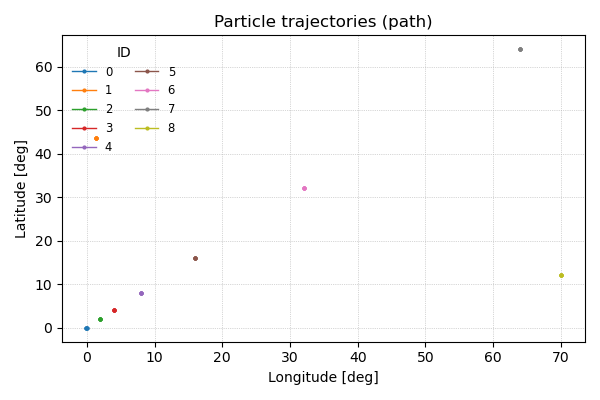Note
Go to the end to download the full example code.
Drift paths from geostrophic velocity fields (path)#
This example reproduces, in a compact and executable form, the workflow
documented in the console script guide for path (see
[docs/source/scripts/path.rst](https://cnes.github.io/aviso-lagrangian/scripts/path.html)).
It shows how to:
Build the configuration of a velocity time series from a list of NetCDF files (using the same template as in
tests/map.ini)Run the console entry-point programmatically to compute the trajectories of a set of points listed in
tests/buoys.txtInspect the ASCII output and display the trajectories on a simple plot
Input and configuration#
We propagate a small set of points from 2010-01-01 to 2010-01-02 using the
built-in test dataset. The configuration uses the same template as in the
documentation and the unit tests, relying on an environment variable ROOT
to locate the test data folder.
from __future__ import annotations
import csv
import os
import pathlib
import sys
import tempfile
from collections import defaultdict
from datetime import datetime
import matplotlib.pyplot as plt
import lagrangian
# The console script we want to run programmatically
from lagrangian.console_scripts.path import main as path_main
Define the ROOT folder of this example (the examples directory)
EXAMPLES_DIRECTORY_PATH = pathlib.Path().absolute()
Define the base directory for tests data (used by SampleDataHandler)
TESTS_DIRECTORY_PATH = EXAMPLES_DIRECTORY_PATH.parent / 'tests'
Use the built-in test data provided by the lagrangian library, but store it in the tests folder so it can be reused by other gallery examples.
class SampleDataHandler(lagrangian.SampleDataHandler):
ROOT = TESTS_DIRECTORY_PATH
# Download the built-in test data if not already present
SampleDataHandler()
<__main__.SampleDataHandler object at 0x7f6932817c50>
Prepare the configuration and input files (reusing tests/map.ini and
tests/buoys.txt). The configuration relies on ${ROOT}, which we set
to the built-in test data folder.
os.environ['ROOT'] = str(SampleDataHandler.folder())
map_ini_path = TESTS_DIRECTORY_PATH / 'map.ini'
buoys_txt_path = TESTS_DIRECTORY_PATH / 'buoys.txt'
Define the output ASCII file path for the trajectories
out_txt = pathlib.Path(tempfile.gettempdir()) / 'paths_gallery.txt'
Define the command line arguments to run the console script
sys.argv = [
'path',
str(map_ini_path),
str(buoys_txt_path),
'2010-01-01',
'2010-01-02',
'--output',
str(out_txt),
]
Run the console script programmatically
path_main()
Load the generated ASCII output. The format is tab-separated with 4 columns: index, longitude, latitude, ISO8601 timestamp. We’ll parse it and show the first few entries for inspection.
rows: list[tuple[int, float, float, datetime]] = []
with open(out_txt) as f:
reader = csv.reader(f, delimiter='\t')
for idx_str, lon_str, lat_str, ts_str in reader:
rows.append((
int(idx_str),
float(lon_str),
float(lat_str),
datetime.fromisoformat(ts_str),
))
print('Preview of path output (first 10 lines):')
for r in rows[:10]:
print(f"{r[0]}\t{r[1]:.6f}\t{r[2]:.6f}\t{r[3].isoformat()}")
Preview of path output (first 10 lines):
0 0.000000 0.000000 2010-01-01T00:00:00
1 1.433333 43.600000 2010-01-01T00:00:00
2 2.000000 2.000000 2010-01-01T00:00:00
3 4.000000 4.000000 2010-01-01T00:00:00
4 8.000000 8.000000 2010-01-01T00:00:00
5 16.000000 16.000000 2010-01-01T00:00:00
6 32.000000 32.000000 2010-01-01T00:00:00
7 64.000000 64.000000 2010-01-01T00:00:00
8 70.000000 12.000000 2010-01-01T00:00:00
0 -0.038031 -0.013479 2010-01-01T06:00:00
Plot trajectories by connecting positions for each particle index. This is a simple geographic plot in lon/lat without map projection for brevity.
tracks: dict[int, list[tuple[float, float]]] = defaultdict(list)
for pid, lon, lat, _ in rows:
tracks[pid].append((lon, lat))
fig, ax = plt.subplots(figsize=(6, 4))
for pid, pts in sorted(tracks.items()):
if not pts:
continue
xs, ys = zip(*pts)
ax.plot(xs, ys, marker='o', markersize=2, linewidth=1, label=str(pid))
ax.set_title('Particle trajectories (path)')
ax.set_xlabel('Longitude [deg]')
ax.set_ylabel('Latitude [deg]')
ax.legend(title='ID',
loc='upper left',
ncol=2,
fontsize='small',
frameon=False)
ax.grid(True, linestyle=':', linewidth=0.5)
plt.tight_layout()

Total running time of the script: (0 minutes 0.253 seconds)